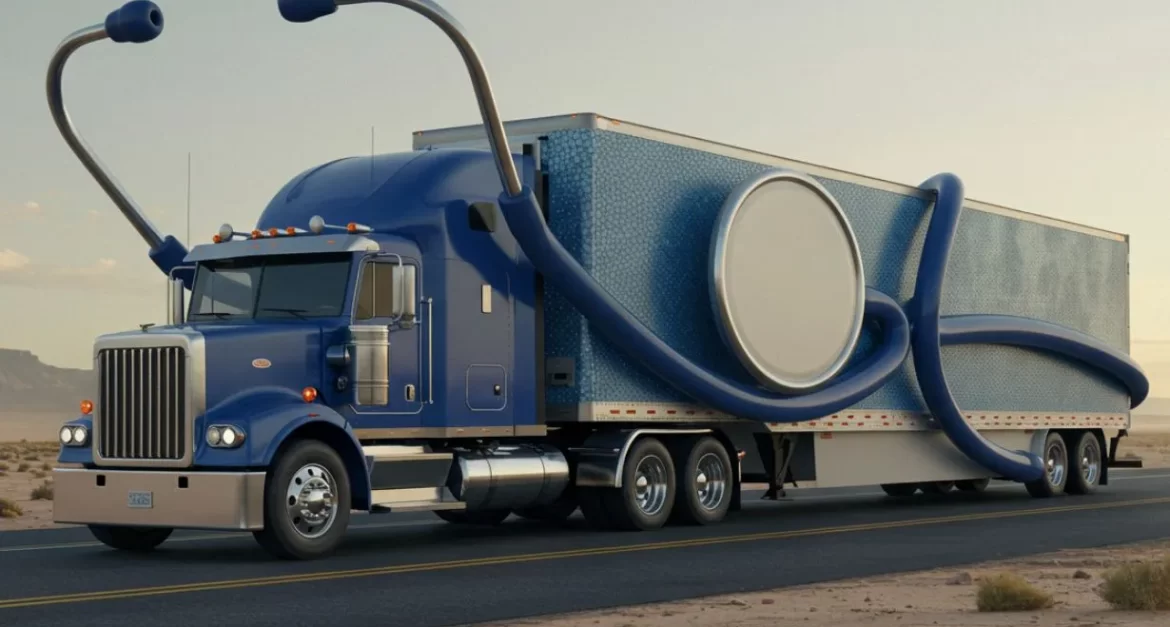
How to pick the right healthcare insurance.
No time to read the whole post. How about listen time while driving?
If there’s one thing we owner operators know, it’s that life on the road is anything but predictable! Between managing contracts, meeting delivery deadlines, and juggling personal commitments, finding time to think about healthcare can feel like a lot. Yet, ensuring you have the right insurance plan is one of the most crucial decisions you’ll make—for both your physical health and your financial well-being.
This blog post will walk you through the essential factors to consider when choosing your 2025 healthcare insurance plan. We’ll explore everything from ACA (often referred to as “Obama Care”) and Private Plans, to Individual Plans, Spouse Plans, and even coverage options through Industry Associations. We’ll also touch on key features like Premium Pays, Copays, and Enrollment Period details. By the end, you’ll have a clear, practical roadmap for making the best choice for your unique situation out on the open road.
Why Your Insurance Choice Matters More Than Ever
Being your own boss has its perks, but it also means you’re the one responsible for picking the right healthcare coverage. As a contractor and owner operator, you don’t have an employer negotiating group rates or automatically enrolling you in a plan. Instead, you have to navigate the Healthcare Marketplace, vet Private Plans, and figure out whether local or nationwide coverage best fits your lifestyle.
Staying Compliant with the ACA
The Affordable Care Act (ACA) opened the door for individuals—especially the self-employed—to purchase comprehensive insurance on the Healthcare Marketplace with potential access to premium tax credits that can help lower monthly costs. According to a HealthInsurance.org guide on self-employed coverage, these ACA-compliant plans often include essential health benefits such as hospital care, prescription drug coverage, mental health services, and more.
The Key Terminology You Need to Know
- Premium Pays: Your monthly payment to keep your policy active. Plans with lower premiums typically have higher out-of-pocket costs.
- Deductible: The amount you pay before insurance starts contributing.
- Copays: A fixed amount you pay for a specific service, like a doctor’s visit.
- Coinsurance: The percentage of a medical bill you pay after meeting your deductible.
- Enrollment Period: A set time of the year (typically late fall into early winter) when you can purchase or change your health insurance plan without needing a special reason.


Your Main Options: ACA, Private, Spouse, or Association?
- ACA (“Obama Care”) Plans
- Where to Find Them: The official Healthcare.gov site or your state’s marketplace site.
- Why It Matters: You may qualify for subsidies (premium tax credits) based on your income level, significantly reducing monthly Premium Pays. Plans cover the 10 essential health benefits, including preventive care, hospital stays, and prescription drugs.
- Enrollment Period: Typically runs from November 1 to January 15 for most states, though some states adjust their dates. If you miss it, you’d need a qualifying life event (like losing other coverage or moving) to enroll.
- Private Plans
- Where to Find Them: Directly from insurance companies or through brokers.
- Key Advantage: Freedom to pick from a broad range of coverage levels and network types—HMOs, PPOs, EPOs, etc.
- Things to Watch: May be pricier than ACA plans for similar coverage, and pre-existing conditions can be an issue for some less-regulated options (like short-term coverage). Always confirm the plan is comprehensive if that’s what you need.
- Spouse Plan
- When It’s Applicable: If your spouse has insurance through their employer or has a strong Individual Plan.
- Benefit: Often, joining a spouse’s plan can save money because it spreads risk across a larger pool of insured individuals. Plus, it may offer better coverage tiers if it’s an employer-sponsored plan.
- Potential Drawback: Depending on your travel schedule, confirm you’ll have enough in-network coverage on the road.
- Industry Associations
- Where to Look: Groups like the Owner Operator Independent Drivers Association (OOIDA) or the Truckers Service Association (TSA) often have specialized insurance products.
- Advantages: Plans crafted for truckers’ unique needs, possible group rates, and coverage that considers life on the road. For instance, TSA partners with TrueChoices to offer coverage tailored to independent drivers.
- Considerations: Some association plans may not include all ACA-mandated essential health benefits; read the fine print to ensure you’re getting adequate coverage.
Comparing Plan Types at a Glance
If you’re feeling overwhelmed by the terms (HMO, PPO, EPO, POS), here’s a quick snapshot:
| Plan Type | Network Size | Referral Needed? | Out-of-Network Coverage | Potential Costs |
|---|---|---|---|---|
| HMO | Typically Local/Regional | Yes, PCP (Primary Care Physician) needed | Usually Not Covered (Emergencies Only) | Lower premiums but less flexibility |
| PPO | Broader/Nationwide | No | Covered, but at a higher cost | Higher premiums, more flexible networks |
| EPO | Medium to Large Network | Not typically | Usually Not Covered (Emergencies Only) | Premiums somewhat in-between HMO & PPO |
| POS | Medium | Yes, PCP referral for out-of-network | Covered with referral | Moderately priced, combines HMO & PPO features |
For owner operators who traverse state lines weekly, a PPO might be a better fit because it often provides coverage in multiple locations without requiring constant referrals. However, if you mostly operate in one region, an HMO or EPO could offer lower monthly Premium Pays, so long as you stay in-network.
Special Considerations for Truckers
- Nationwide Coverage
- You’re often crossing multiple states, so prioritize a plan with robust nationwide networks—insurers like Blue Cross Blue Shield sometimes offer extensive coast-to-coast options.
- Mental Health Services
- Long hours alone on the road can be stressful. Ensure your plan covers counseling or telehealth mental health support. ACA-compliant plans typically do, but short-term policies sometimes exclude it entirely.
- Preventive Services
- Routine checkups can catch issues early. ACA plans provide preventive care (like annual physicals) at no extra cost when you see an in-network provider.
- Chronic Conditions & Maintenance Medications
- If you’re managing diabetes or high blood pressure (both common among truckers, as noted in a Pro Driver U article), double-check that your plan’s formulary (the list of covered medications) includes what you need at a manageable Copay.
What About Short-Term or “Gap” Coverage?
Short-term plans can be appealing, especially if you missed the Enrollment Period and want some coverage until the next one. However, these policies often:
- Exclude pre-existing conditions entirely.
- May not cover essential benefits like maternity or mental health.
- Have higher out-of-pocket limits.
In other words, short-term plans are typically not designed for long-term coverage and do not meet the ACA’s requirements. They can work as a temporary fix, but if you have ongoing medical needs, you could end up with large bills. UnitedHealthcare outlines some key pros and cons of these plans to help you decide if it’s a fit for your situation.
Don’t Forget the Enrollment Periods!
Most ACA-compliant and some Private Plans restrict sign-ups to the Open Enrollment Period (OEP), which generally runs from November 1, 2024, to January 15, 2025, for coverage starting in 2025. As highlighted by eHealthInsurance, if you miss that window, you’ll need a Special Enrollment Period (SEP) qualifying event—such as losing other coverage, getting married, or moving—to sign up midyear.
Pro Tip: Mark these dates in your calendar well ahead of time. Missing enrollment can limit your options to short-term plans (which we just learned have significant downsides).
Balancing Budget and Benefits
Owner operators are acutely aware of business expenses, and health insurance is no exception. The big challenge is balancing manageable monthly premiums with enough coverage to avoid catastrophic out-of-pocket bills.
- Estimate Your Medical Needs
If you’re relatively healthy, you might opt for a lower-premium, higher-deductible plan (like a Bronze ACA plan). Just remember: your Copays and coinsurance will generally be higher.
- Plan for the Unexpected
Even if you’re a picture of perfect health, accidents can happen. Consider how much you can comfortably pay out of pocket if you need emergency care far from home. A Platinum plan might cost more monthly but can save you if something big happens.
- Check for Subsidies
When you apply through the Marketplace, you’ll see if you qualify for subsidies based on your estimated income. That’s “free money” toward your premiums, and you might also get reduced copays or deductibles if you choose a Silver plan and your income falls within specific brackets.
A Quick Recap of Your To-Do List
- Identify Your Top Priorities: Nationwide network? Lower monthly Premium Pays? Specific providers you want in-network?
- Review Your Budget: Factor in not just premiums, but also potential out-of-pocket costs like deductibles, Copays, and coinsurance.
- Consider ACA vs. Private vs. Spouse vs. Association: If your spouse’s plan is robust and affordable, that might be a great deal. Otherwise, investigate Industry Associations such as OOIDA or TSA.
- Remember Enrollment Dates: Mark your calendar so you don’t miss crucial deadlines.
- Compare Plans Thoroughly: Use online marketplaces or talk to a licensed broker who understands the trucking industry and your specific needs.
Conclusion: Your Health Matters—Don’t Put It in the Rearview
Driving a big rig across the country might be your passion, but managing your health and finances is just as important as delivering freight on time. Whether you choose an ACA plan on the Healthcare Marketplace, a Private Plan, coverage through Industry Associations, or get added to a Spouse Plan, make sure you understand the trade-offs in cost and coverage. Look closely at premium pays, copays, deductibles, and that all-important out-of-pocket maximum. And most importantly, choose a plan that suits your unique situation—after all, nobody knows your road better than you do.
Before the next route sends you roaring down the highway, take a pit stop to get your 2025 health insurance in order. Think of it as preventative maintenance for your most important asset: you.
Safe travels and good health!
FAQ for How to pick the right Healthcare Insurance for Owner Operators
1. Why is choosing the right healthcare insurance particularly important for owner operators?
2. What are some key healthcare insurance terms owner operators should understand?
* Deductible: The amount you must pay out-of-pocket for covered services before your insurance starts contributing.
* Copays: A fixed amount you pay for specific services, like a doctor's visit, after your deductible (if applicable).
* Coinsurance: The percentage of a medical bill you pay after meeting your deductible.
* Enrollment Period: A specific time of year (usually late fall to early winter) when you can purchase or change health insurance plans.
3. What are the main healthcare insurance options for owner-operators
* Private Plans: Purchased directly from insurance companies or through brokers.
* Spouse Plan: Joining a spouse's employer-sponsored or individual plan.
* Industry Associations: Plans offered through groups like OOIDA or TSA, sometimes tailored for truckers.
4, What are the benefits of considering an ACA (Affordable Care Act) plan through the Healthcare Marketplace?
5. What is the typical Open Enrollment Period for ACA plans mentioned for 2025 coverage?
6. When might joining a Spouse's Plan be a good option?
7. The article compares HMO, PPO, EPO, and POS plans. Which type is often suggested as a better fit for owner operators who travel extensively, and why?
8. What specific coverage aspects are particularly important for truckers to consider?
* Mental Health Services: Coverage for counseling or telehealth, as long hours on the road can be stressful.
* Preventive Services: For routine checkups, often covered at no extra cost in ACA plans with in-network providers.
* Chronic Conditions & Maintenance Medications: Ensuring the plan’s formulary covers necessary medications at manageable copays.